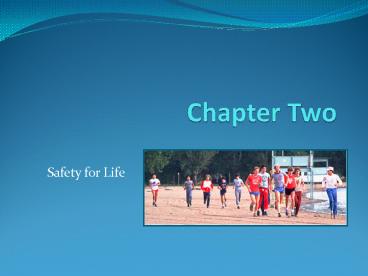Chapter Two - PowerPoint PPT Presentation
Title:
Chapter Two
Description:
... during and after exercise. Heat Illnesses There are 3 heat illnesses associated with fluid loss which you should understand and recognize: ... – PowerPoint PPT presentation
Number of Views:110
Avg rating:3.0/5.0
Title: Chapter Two
1
Chapter Two
- Safety for Life
2
(No Transcript)
3
The Warm-up
- The warm up should last for about 5 to 10
minutes. You can perform movements similar to
the activity you will be performing, such as
walking or slow jogging before a walk or run
workout, or swinging a bat before playing
softball or baseball.
4
The Cool-down
- After you finish exercising, it is very
important to spend about 5 to 10 minutes cooling
down. Slow down but always keep moving. If you
have been running, slow down to a jog or walk.
5
The Biomechanical Principles of Exercise
Biomechanics is the study of human motion and the
effect that forces have on the body. If you
understand these principles, you may perform
movements better and also reduce your chances of
exercise-related injuries.
6
Selecting Exercise Clothing
- Hot Weather
- For warm or hot weather exercise choose cotton or
special synthetic materials that allow your
perspiration to evaporate which will help cool
your body. Light colored or white clothing
reflect the suns rays.
7
Selecting Exercise Clothing
- Cold Weather
- Wear layers of clothing so you can remove the
outer layer as your body heats up during
exercise. Wear several layers of light clothing,
not one heavy layer. The inside layers should
allow perspiration to evaporate. The outer layer
should repel water, be windproof and breathable.
Hats or caps help keep your head warm. Wear
sunglasses when exercising in snow on a bright
day to protect your eyes. Be sure your shoes
have good traction if you are running on frozen
ground.
8
Socks
- Proper fitting socks can help prevent blisters.
Some people prefer to wear two pairs of socks for
extra protection. Choose cotton, wool, or special
synthetic fibers which help absorb perspiration.
Clean, dry socks will help keep your feet healthy.
9
Selecting Footwear
- Type of activity
- Your foot type
- Shoes that fit
- Type of shoe construction
10
Exercising in Hot Weather
- Workout at the coolest part of the day
- Reduce the intensity and length of your workouts
until your body adjusts to the heat. - Drink plenty of fluids, especially water, before,
during and after exercise.
11
Heat Illnesses
- There are 3 heat illnesses associated with fluid
loss which you should understand and recognize - Heat Cramps
- Heat Exhaustion
- Heat Stroke
12
Exercising in Cold Weather
- When exercising outside on cold days, you should
remember to drink enough to replace fluid loss
because even in cold weather if you work out hard
enough, you will sweat.
13
The Danger of Lightning Strikes
- Get to a safe shelter or automobile
- Avoid standing under an isolated tree
- Find a low spot and lie down if you are caught in
an open field during a lightning storm. - Get out of lakes, rivers, and pools.
- Stay away from metal poles, fences, golf clubs.
14
Be Sun Smart
- Apply a sunscreen with a high sun protection
factor - at least 30 SPF- before you go out into
the sun. For maximum protection, use sunblock. - If you are swimming or perspiring heavily,
reapply the sunscreen often.. - Try to avoid direct sun between 11 am and 2 pm
when the suns rays are strongest. - Wear a wide-brimmed hat and clothing that
protects your neck, arms, and legs.
15
Avoiding Exercise Problems
- Start slowly and warm up correctly.
- Be careful when switching shoes, sports
equipment, and exercise surfaces (wood to
concrete, grass to pavement). - When your muscles are tired at the end of a
workout, be careful. - Cool down correctly and stretch after exercise to
improve flexibility.
16
Common Exercise Problems
- Muscle soreness
- Muscle cramps
- Sprains
- Muscle Strains
17
Injury Treatment - The PRICE Method
- Protect from further injury by using splints,
pads or crutches - Restrict activity - rest the injured part
- Apply ICE to reduce inflammation and pain
- Compression or pressure reduces blood flow and
swelling - Elevate the injured area.
18
Exercising Safely
- Follow the safety precautions when participating
in an activity program or sports program.
Return to Chapter Menu































